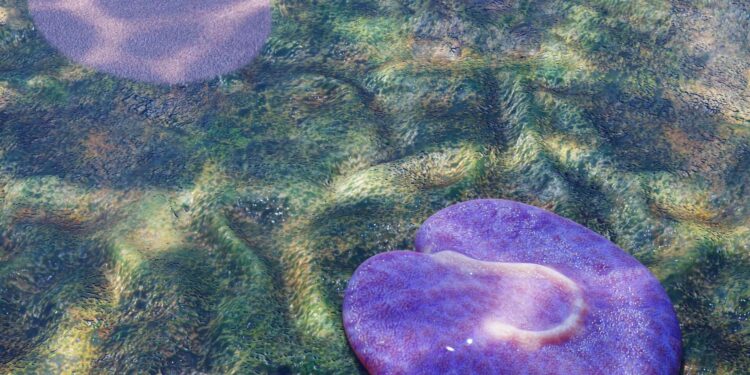Artistic rendering of what scientists looked like according to Quaestio simpsonorum. Credit: Walker Weyland.
In the shadow of South Australia’s largest mountain range, beneath the outback soil, lie a fossil record that reveals a rich history of life on Earth. Fossils discovered in Nilpena Ediacara National Park preserve a pivotal moment in evolutionary history: the crucial period when single-celled organisms began to evolve into the planet’s first complex, visible animals.
A new discovery in the region by Scott Evans, assistant professor of geology in the Department of Earth, Ocean and Atmospheric Sciences at Florida State University, and a multi-institutional team of paleontologists has identified a first marine animal dating back around 555 million years. This discovery helps us understand how life evolved on Earth.
Quaestio simpsonorum is the first animal to exhibit definitive left-right asymmetry, an important sign of evolutionary development. The team’s findings appear in Evolution and development.
Join our new WhatsApp channel! Stay up to date with the latest science news from Science X.
“The animal is a little smaller than the size of your palm and has a question mark shape in the middle of its body that distinguishes the left side from the right side,” Evans said. “There are no other fossils from this time that show this type of organization so definitively. It’s particularly interesting because it’s also one of the first animals capable of moving on its own.”
Researchers said Quaestio, pronounced “kways-tee-oh”, behaved like a small Roomba marine vacuum cleaner, consuming nutrients from microscopic algae, bacteria and other organisms as it moved along the sea floor . The collection of microbes formed an organic mat, like a layer of nutrient-filled silt on the seafloor, which formed a distinctive texture preserved in the rock slabs that make up the park’s fossil beds. Researchers discovered distinct impressions of Quaestio as well as evidence of its tracks, known as trace fossils, in this fossilized carpet texture.
“One of the most exciting moments during the excavation of the bed where we found many Quaestio was when we turned over a rock, brushed it and spotted what was obviously a trace fossil behind a specimen of Quaestio – a clear sign that the organism was mobile; it could move,” said Ian Hughes, a graduate student in organic and evolutionary biology at Harvard University and one of the team’s researchers.
The team also includes researchers from the University of California, Riverside, the South Australian Museum and the University of Adelaide, Australia.
Mary Droser, Nilpena’s principal scientist, distinguished professor of geology at UC Riverside, and Evans’ former doctoral advisor, guided this team on excavations in the outback for more than 20 years.
“It’s incredibly informative in informing us about how animal life on Earth happened,” Droser said. “We are the only planet we know of with life, so when we look to find life on other planets, we can go back in time on Earth to see how life evolved on this planet. The study of the history of life through fossils tells us how animals evolved and what processes cause their extinction, whether it is climate change or a lack of oxygen.
The Nilpena Ediacara National Park opened to the public in early 2023 and is part of a bid for recognition as a UNESCO World Heritage Site. UNESCO World Heritage Sites are natural or cultural sites considered to be of outstanding universal value and are protected by international convention.
The researchers said the effort is due in large part to the work and generosity of Mary Lou Simpson, founder and president of the Flinders Ranges Ediacara Foundation, and her husband Antony Simpson, in whose honor Quaestio simpsonorum owes its name.
“As the oldest fossil animal, the Ediacaran biota can tell us a lot about early developmental processes,” Evans said. “Determining the genetic expressions necessary to construct these forms provides a new method for assessing the mechanisms responsible for the beginnings of complex life on this planet.
“Because animals today use the same basic genetic programming to form distinct left and right sides, we can be reasonably sure that these same genes worked to produce these characteristics in Quaestio, an animal that has been extinct for more than ‘half a billion years.’
Although the team has been excavating there for decades – in fossil beds and rock slabs ranging from the size of a fingernail to a slab weighing several hundred pounds – Quaestio was only recently discovered on the one of the most recent excavation sites in the park. a collaborative effort with volunteers from the South Australia Museum. The research team hopes to continue to re-examine sites across nearly 150,000 acres of the park.
“We still find new things every time we dig,” Hughes said. “Even though these were some of the world’s earliest animal ecosystems, they were already very diverse. We are seeing an explosion of life very early in the history of animal evolution.”
More information:
Scott D. Evans et al, A new mobile animal with implications for the evolution of axial polarity from the Ediacaran of South Australia, Evolution and development (2024). DOI: 10.1111/ede.12491
Provided by Florida State University
Quote: Scientists discover one of Earth’s first animals in the Australian outback (October 14, 2024) retrieved October 15, 2024 from
This document is subject to copyright. Except for fair use for private study or research purposes, no part may be reproduced without written permission. The content is provided for informational purposes only.



